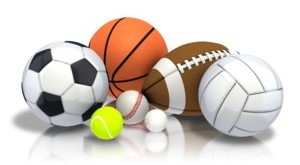Mission Statement
The mission of our program is to educate each student in the cognitive, affective, and psychomotor domains of learning as it relates to Physical Education. It is our intent to challenge each student to attain the highest level of personal fitness, skill, knowledge, responsibility, integrity, and sportsmanship as it relates to Physical Education. It is our intent to develop a personal aspiration in each child to strive for excellence in all areas of their lives.
Playground Rules
Local Sports Opportunities
Nutrition Terms
Carbohydrate: Foods used for energy including fruits, breads, vegetables, rice, pasta.
Protein: Foods used to repair cells and muscles in the body including meat, eggs, milk, nuts, beans, chicken, and fish.
Fat: Foods used for energy that can be harmful to the body if eaten too often. Includes butter, cheese, oils, mayonnaise, salad dressing, nuts, and fatty meat.
Minerals: The body uses these to perform many different functions- from building strong bones to transmitting nerve
messages. Some are even used to make hormones or maintain a normal heartbeat.
Calcium: This mineral helps build strong bones, so you can do everything from standing up straight to scoring that winning goal. It also helps build strong, healthy teeth, for chomping on tasty food.
Iron: This mineral transports oxygen from your lungs to the rest of your body. Your entire body needs oxygen to stay healthy and alive.
Vitamins: are substances that are found in foods we eat. Your body needs them to work properly, so you grow and develop just like you should. When it comes to vitamins, each
one has a special role to play.
For example:
Vitamin D in milk helps your bones.
Vitamin A in carrots helps you see at night.
Vitamin C in oranges helps your body heal if you get a cut.
Vitamin B in leafy green vegetables help your body make
protein and energy.
Water: The body is 55-75% water. Liquid needed to survive.
Fiber: Hard to digest food that is healthy for the intestines.
Includes certain vegetables, grains, and fruit.
PE Terms
Muscle Endurance: Being able to use your muscles for a long period of time.
Muscle Strength: How strong your muscles are at different events.
Flexibility: Keeping your muscles stretched to stop from getting hurt.
Aerobic Endurance: Being able to exercise for long periods of time without running out of breath.
Body Composition: How much muscle you have compared to how much fat you have.
Aerobic Exercise: Aerobic exercise helps make the heart and lungs stronger by increasing the oxygen available to the body and by enabling the heart to use oxygen better. It uses the same large muscle group, rhythmically, for a period of 15 to 20 minutes or longer while maintaining 60-80% of your maximum heart rate. Aerobic activities include: walking, biking,
jogging, swimming, aerobic classes and cross-country skiing.
Anaerobic Exercise: Anaerobic activity is short in time but high in effort.
Anaerobic activities include: racquetball, downhill skiing, weight lifting, sprinting, softball, soccer, and football.
Ectomorph: This body type is characterized by a light build and slight muscular development. Ectomorphs may even have trouble gaining weight and feel they are too thin. As with other body types, people who fall into this category should exercise, but will have a different focus. Because they are often trying to gain weight, an ectomorph might spend more time on strength training and a bit less time on cardio work. (1)
Endomorph: This body type is characterized by a stocky build, wide hips, and the annoying tendency to easily store body fat. Endomorphs may also have more internal fat around the organs, which makes fat loss more difficult than other body types. People with this body type will want to pay close attention to their diets and make sure to follow a complete exercise program that includes cardio and strength training. (2)
Mesomorph: This body type tends to be more muscular, with a large chest and a long torso. A person with this body type may find it a little easier to build muscle than others. (3)
(1) By Paige Waehner, About.com
(2) By Paige Waehner, About.com
(3) By Paige Waehner, About.com

